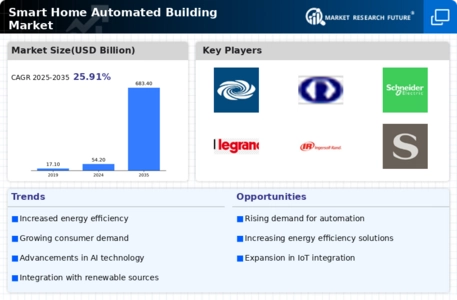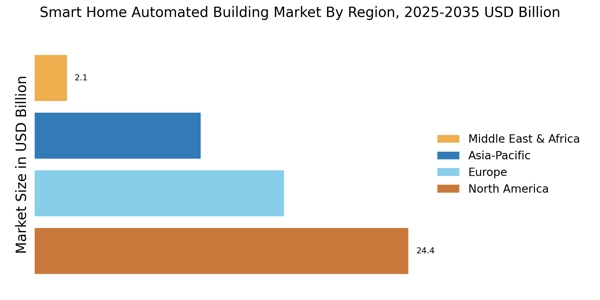Increased Focus on Home Security
The Smart Home Automated Building Market is increasingly shaped by a heightened focus on home security. With rising concerns about safety and property protection, consumers are turning to smart security systems that offer advanced features such as remote monitoring, motion detection, and real-time alerts. The market for smart security devices is projected to grow significantly, with estimates suggesting it could reach over 40 billion dollars by 2025. This growth is indicative of a broader trend where homeowners prioritize security as a key component of their smart home experience. As a result, the Smart Home Automated Building Market is likely to see a surge in demand for innovative security solutions that provide peace of mind.
Integration of Smart Home Ecosystems
The Smart Home Automated Building Market is benefiting from the integration of smart home ecosystems. As consumers increasingly seek cohesive solutions that connect various devices and systems, the demand for platforms that facilitate this integration is on the rise. Companies are developing comprehensive ecosystems that allow for seamless communication between devices, enhancing user experience and functionality. Market analysis indicates that the smart home ecosystem segment is expected to grow substantially, driven by consumer preferences for interoperability and ease of use. This trend suggests that the Smart Home Automated Building Market will continue to evolve, offering integrated solutions that cater to the diverse needs of modern homeowners.
Growing Awareness of Energy Efficiency
The Smart Home Automated Building Market is witnessing a growing awareness of energy efficiency among consumers. As energy costs continue to rise, homeowners are becoming more conscious of their energy consumption and its environmental impact. Smart home technologies, such as automated lighting and smart thermostats, offer solutions that optimize energy use, leading to significant cost savings. Recent studies indicate that homes equipped with smart technologies can reduce energy consumption by up to 30%. This heightened focus on sustainability is driving demand for smart home solutions that not only enhance comfort but also promote energy conservation. Consequently, the Smart Home Automated Building Market is likely to benefit from this trend as more consumers seek eco-friendly options.
Rising Consumer Demand for Convenience
The Smart Home Automated Building Market is experiencing a notable surge in consumer demand for convenience and ease of use. As lifestyles become increasingly hectic, homeowners are seeking solutions that simplify daily tasks. This trend is reflected in the growing adoption of smart devices that allow for remote control of home systems, such as lighting, heating, and security. According to recent data, the market for smart home devices is projected to reach a valuation of over 100 billion dollars by 2025. This indicates a robust growth trajectory, driven by the desire for seamless integration of technology into everyday life. As consumers prioritize convenience, the Smart Home Automated Building Market is likely to expand, offering innovative solutions that cater to these evolving preferences.
Advancements in Internet of Things (IoT) Technology
The Smart Home Automated Building Market is significantly influenced by advancements in Internet of Things (IoT) technology. The proliferation of connected devices enables homeowners to monitor and control their environments with unprecedented ease. IoT technology facilitates the integration of various systems, such as security, lighting, and climate control, into a cohesive network. This interconnectedness not only enhances user experience but also contributes to energy efficiency. Market data suggests that the IoT sector is expected to grow exponentially, with billions of devices projected to be connected by 2025. This growth is likely to propel the Smart Home Automated Building Market forward, as consumers increasingly seek smart solutions that leverage IoT capabilities.


















Leave a Comment